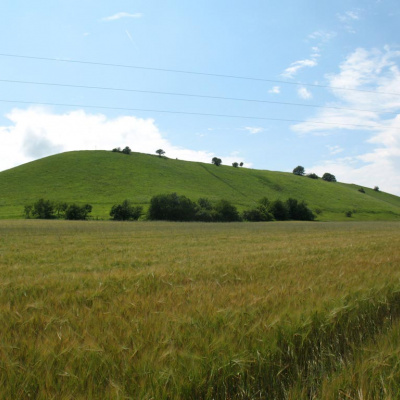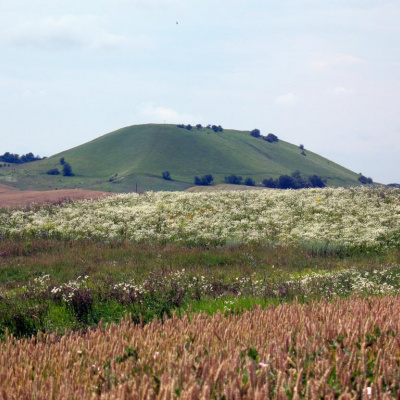Devil's Mountain, Rohatyn
Chortova Hora is a unique botanical natural monument of national importance in Ukraine, a remnant of the Ice Age. Several species of ancient flora grow on the territory. It is located near Rohatyn, to the right of the road to Berezhany in Rohatyn district of Ivano-Frankivsk region, east of the city of Rohatyn. The area of the protected area is 13 hectares. It has been protected since 1975. It is under the jurisdiction of Pidvynianske village council and Pukiv village council. At the top you can see the remains of a sacred type settlement: a symbolic rampart with an inner moat, a temple, pits and depressions from buildings.
Thanks to the active support of Metropolitan Andriy, a unique area of steppe relict vegetation, the Chortova Hora tract near the city of Rohatyn, was set aside as a nature reserve on the Church's land. In 1935, a local parish priest, Fr. Theodosius Kudryk, discovered a plot of steppe relict vegetation. Subsequently, botanists studying the flora of this site confirmed its uniqueness, and with the consent and support of Metropolitan Andrey, it was formalized as the Devil's Mountain Reserve.
On July 7, 1936, the Greek Catholic Metropolitan Order in Lviv sent a letter to the voivodeship government in Stanyslaviv informing them of the creation of the Chortova Hora reserve on the lands of the Greek Catholic parish in Rohatyn and its transfer "to the care of the National Science School in Lviv for scientific research."
The natural monument covers the territory of the slopes and the top of the hill called Chortova Hora (350 m), located within Rohatyn Opillia, near the M12 highway, between Rohatyn and the village of Pukiv. The natural center of meadow-steppe vegetation, which is unique for Prykarpattia, is protected. The grass cover is home to pale fescue, common viper's mullein, meadow sage, lily of the valley, spring mountaineer, as well as hairy feather grass and two-leaved lovegrass, all of which are listed in the Red Book of Ukraine.
There is a legend about the name of this mountain: long ago, devils and other evil spirits decided to harm the townspeople because they were very pious. So, they decided to throw an earthen mountain on the city so that everyone would die. The devils gathered the earth and carried it away, but then the roosters crowed, and the evil spirits had to hide. And in the city where they were caught by dawn, a large earthen mountain remained, carried by the evil spirits to destroy the people of Rohatyn. This hill is unique - it is home to steppe vegetation that has miraculously survived here. In front of the Devil's Mountain there is a mountain with a mystical name called the Grave.
According to another legend, there is a big, big stone on Devil's Mountain, under which, if you lift it, there is a gate to hell. But even without the old legends, both "Bald Mountains" without vegetation are striking in their mysticism. Locals say that near the Devil's Mountain people are often haunted by fornication or evil spirits.
It is possible that the legends even complement each other. Each of them contains deep symbolism: in fairy tales and legends, devils are often the priests of ancient cults; an offense against the city is an attempt to impose a curse or take revenge for apostasy in the faith; the entrance to hell is the gateway to the world where monks believe that demon-priests rule. It is likely that the legends about the mountain originated at a time when Christianity had already established itself in the region, but there were still pagan communities, and there was competition between representatives of different religions.
The name of the mountain haunts some local "activists": In 1994, the community of the village of Pukiv erected a wooden cross on the edge of the mountain's peak, calling the mountain "God's". But this caused a wave of indignation from the residents of the surrounding villages (that year it did not rain for a month, and so they blamed the cross on the mountain, saying that it did not make it rain), so it is still called Chortova. The locals also believe that the mountain has magical powers - it can disperse storm clouds, or vice versa - the mountain attracts clouds like a magnet. It is also interesting that, according to an ancient custom, brides like to come here on their wedding day, and this is a remnant of ancient pagan rituals (for example, in some places, a walk to a sacred tree or stone has been preserved).
At the foot of the Devil's Mountain there is an artificial terrace (or moat) that encircles the rest of the mountain. The slopes are quite steep. The vegetation is of the steppe-meadow type, as indicated in the encyclopedia. The top can be divided into three parts. The lowest and narrowest is the northwestern one. The central part is located on a hill and is slightly wider than the previous one. The highest is the southeastern part of the mountain, which forms a kind of plateau. The latter stretches from west to east with a slope to the south. From above, it resembles a human right foot (it is likely that this circumstance could add a certain cultic character to the place).
According to the characteristic features, we can assume that there was a settlement-sanctuary of the ancient Slavs:
- all the main buildings are located on a hill;
- a small rampart around the settlement, which served a symbolic function;
- there are specially equipped platforms for ceremonies surrounded by ritual ramparts, the sacred boundary of the sanctuary;
- the remains of a temple with nearby sacrificial pits, a pillar pit for a probable idol;
- division of the settlement into sacred and public parts.

Map diagram of some discovered settlements near the chronicle Rohatyn - B. Yavir Iskra
Probably, the sanctuary was part of a complex of settlements and sanctuaries around a hypothetical princely/boyar center (settlement Lukovyshche).
To add a comment you can: login or register.




